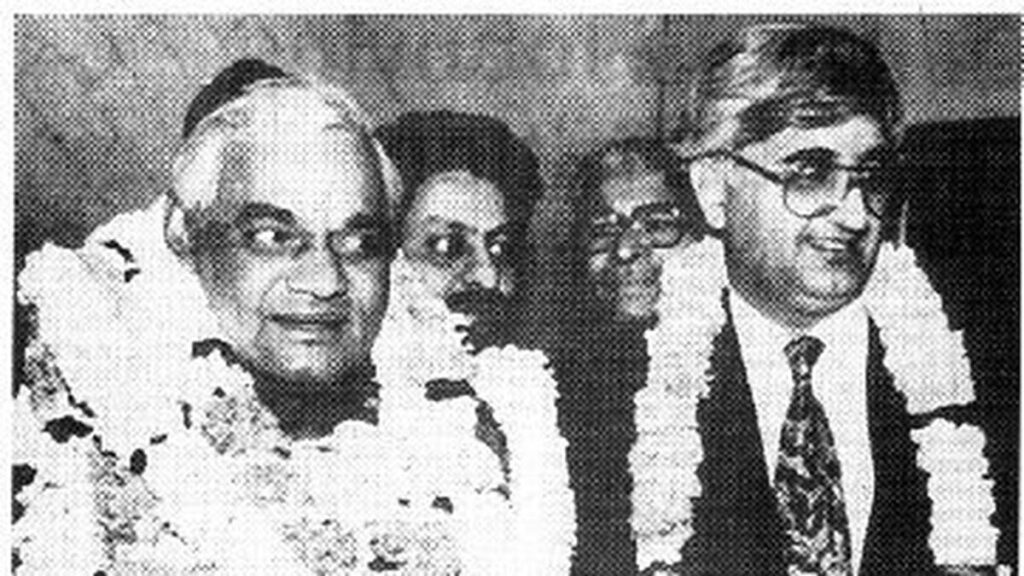
Archive image of Atal Bihari Vajpayee and Salman Khurshid being greeted on their return from Geneva in March 1994
| Photo Credit: PTI
The multi-party delegation being dispatched across the globe after Operation Sindoor has revived memories of a similar phase in Indian diplomatic history when a sustained cross-party campaign was carried out to project a “one India” approach to important issues like Kashmir and the communal situation. The context for the previous effort, which took place in the early 1990s, was the demolition of the Babri Masjid, a spike in violence in Kashmir, and anti-insurgency operations in Punjab.
To make matters worse, there were frequent communal riots that culminated in the 1992-93 Mumbai riots that formed the backdrop of Mani Ratnam’s famous film Bombay.

The neighbourhood was equally challenging, with Pakistan under the leadership of Benazir Bhutto and Bangladesh under Prime Minister Khaleda Zia. Both Benazir Bhutto and Khaleda Zia wanted to take on India, given regional conditions. The regional and domestic situation quickly morphed into a diplomatic challenge for India when Western powers and major international human rights watchdogs turned human rights into a major tool of diplomacy. This was the first time that human rights were being used as a major diplomatic initiative as the post-Cold War world order acquired a unique diplomatic alphabet.
In this context, both Pakistan and Bangladesh highlighted the treatment of the Muslim minority inside India and blended that issue with other matters on their agenda. Bangladesh raked up the Farakka Barrage controversy and argued that the barrage denied human rights to the Bangladeshi people, and Pakistan wanted to corner India on human rights because of the police actions unfolding in Kashmir and, more importantly, in Punjab, where K.P.S. Gill was carrying out anti-insurgency operations. This was the backdrop to the June 1993 United Nations International Conference on Human Rights organised in Vienna.
Prime Minister P.V. Narasimha Rao chose a delegation led by Finance Minister Dr. Manmohan Singh. The other members were Dr. Farooq Abdullah, Indian High Commissioner, jurist L.M. Singhvi, Permanent Representative of India to New York, Hamid Ansari, and Permanent Representative to the U.N. in Geneva, Satish Chandra. The Pakistani delegation was led by the mother of the Prime Minister, Ms. Nusrat Bhutto, who launched a scathing attack on India. Dr. Farooq Abdullah resorted to some tactics that the late Foreign Secretary J.N. Dixit described as “shock therapy” in his book My South Block Years.
Diplomatic battle
Recounting the meeting, Mr. Ansari, who later became Vice-President of India, said that Dr. Singh, on reaching Vienna, immediately summoned a meeting of the team members in the hotel room and said that he did not agree with the draft provided to him by the Ministry of External Affairs. “It was a draft made by the MEA, and Dr. Singh felt the statement was a bit defensive. He wanted to be less defensive. Finally, our team made a good impression and foiled the attempts of our neighbours,” said Mr. Ansari, recollecting the diplomatic battle. The June meeting provided the backdrop for the prolonged human rights campaign that India had to face.
Next came the General Assembly session in September in New York, where External Affairs Minister Dinesh Singh was to lead the delegation. However, he fell ill, and Minister of State for External Affairs Salman Khurshid was diverted from a trip to Latin America and sent to New York to lead the Indian delegation. The meeting turned acrimonious as the Pakistani delegation wanted to corner India in front of the global community. Having been unsuccessful in the first two attempts, Pakistan next planned to float a resolution at the Human Rights Council in Geneva in March 1994. The idea was to first float a resolution on Kashmir at the U.N. International Conference on Human Rights, and then humiliate India by putting the resolution to a vote. A defeat in the vote would have dented India’s diplomatic stature in the world.
PM Rao sent a delegation led by the former External Affairs Minister and leader of the Opposition in the Parliament, Atal Bihari Vajpayee, to the HRC in Geneva. He was joined by MoS for External Affairs Salman Khurshid, Vajpayee’s adviser on foreign affairs Brajesh Mishra, Dr. Farooq Abdullah, and Hamid Ansari.
Pakistan tried its best to take the resolution to a vote, but the Indian team lobbied with Iran to prevent the vote, and finally Iran’s influence over the West Asian and North African countries prevailed, and Pakistan’s attempt at creating a diplomatic embarrassment for India was foiled. During the meeting, a senior member of the Pakistani delegation came to Mr. Ansari and said, “We know we cannot snatch Kashmir away.”
Published – May 18, 2025 11:59 pm IST
Source:https://www.thehindu.com/news/national/diplomatic-outreach-revives-memories-of-dream-teams-that-got-india-out-of-tight-corners/article69591340.ece

